Pawscessories is reader-supported. When you buy via links on our site, we may earn an affiliate commission at no cost to you.
Learn more.
Have you ever wondered what your German Shepherd’s ears mean? Or what their ear stages are when growing up?
There is a lot of meaning behind GSDs’ different ear positions. So we created a German Shepherd ear chart to determine each position’s meaning. We even covered all the stages GSDs ears will go through when growing.
So, whether you are just curious about your dog’s ears or are looking to become a GSD expert, keep reading!
Table of Contents
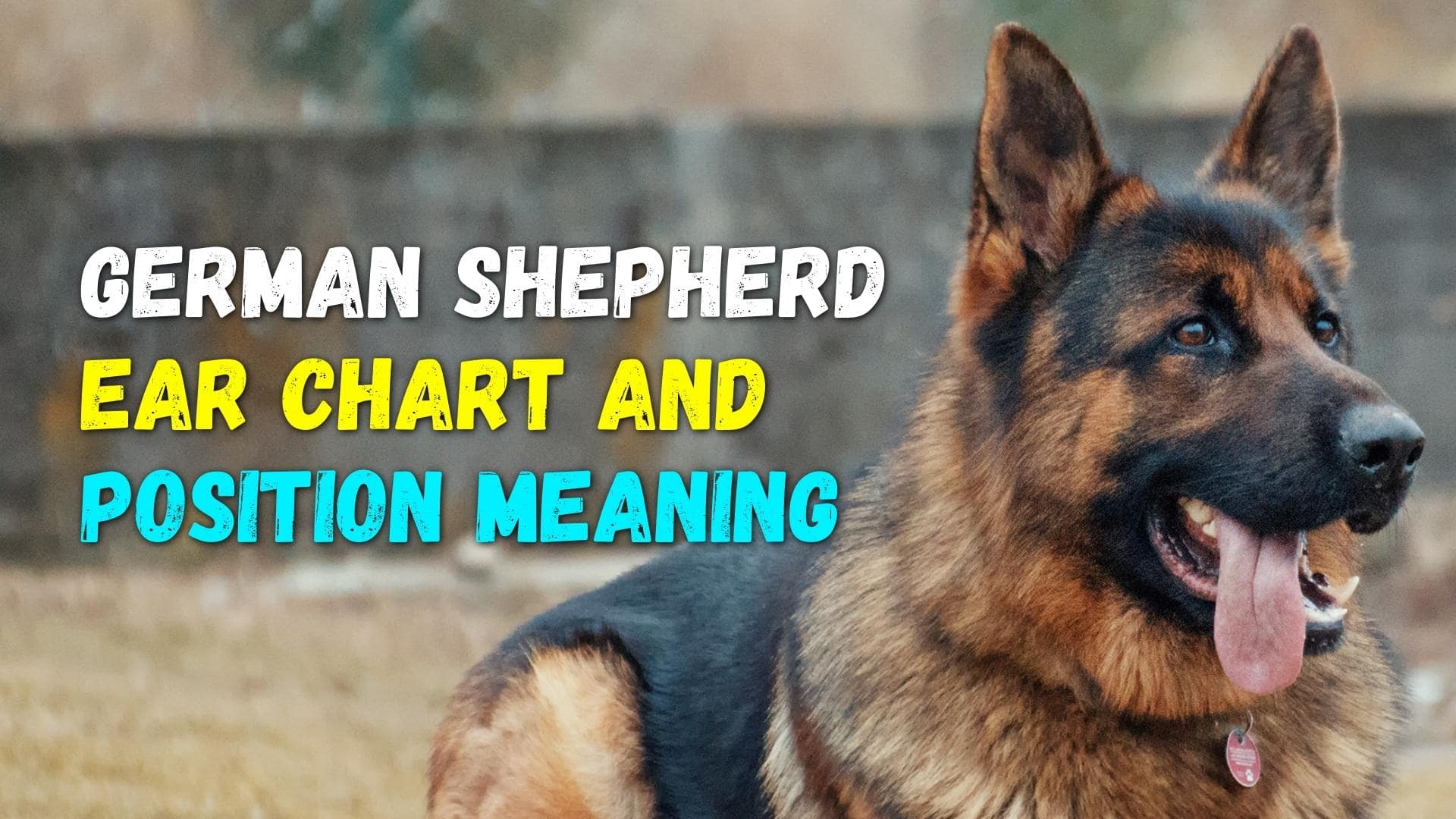
Why Do German Shepherds Move Their Ears?
Your German Shepherd uses their ears for many things. However, the primary use is to communicate with other dogs and people.
Think about it: how often have you seen a dog move their ears back when they meet a new person or dog? This is usually a sign of submission or fear.
On the other hand, when a dog meets someone they are comfortable with, their ears will be in a more relaxed position. This is because ears can directly indicate how a dog is feeling.
In addition, ears are also used for hearing and balance. They help your GSD focus on sounds and balance while walking or running.
German Shepherd Ear Position Chart
| Ear Positions | Emotions |
|---|---|
| Ears Relaxed | Neutral, usually clam |
| Ears Back | Social, nervous, or submissive |
| Ears Down / Flat | Fearful, anxious, Illness, or defensive |
| Ears Perked Up | Alert, curious, defensive, or aggressive |
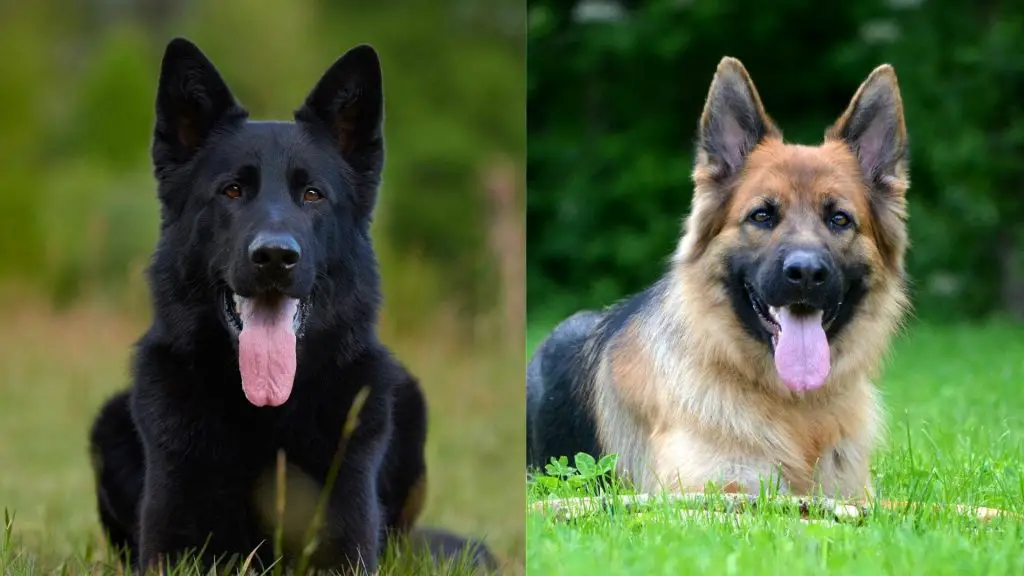
The Different German Shepherd Ear Positions & What They Mean
Now that you know some of the functions of your German Shepherd’s ears let’s get into the different ear positions.
There are many GSD ear positions, but we will only discuss the most common ones.
Here are the different German Shepherd ear positions meanings:
Ears Relaxed And Standing
The most common ear position is relaxed ears.
A German Shepherd’s ears will sit this way when they are just being themselves and feeling comfortable, safe, and happy. Generally, GSDs have erect ears; however, some can have floppy ears even into adulthood.
Most of the time, this is the position their ears will be in, and you shouldn’t worry if you see them in this position.
Ears ‘Pricked’ Forward

This position is when your GSD’s ears are erect and pointing forward.
When a dog’s ears are in this position, they try to focus on something. It could be a sound, person, or animal. If their ears suddenly perked up, something had probably caught their attention.
This ear position is also common when a dog prepares to attack or defend. They are basically on high alert. If you see your German Shepherd’s ears in this position and they seem tense or aggressive, it would be best to remove them from the situation.
Why Do German Shepherds Prick Their Ears?
When a German Shepherd’s ears are perked up, it usually means they’re laser-focused on something, such as another dog or animal.
Furthermore, a GSD whose ears are in this position may be preparing to act aggressively or defensively. For example, they may prick their ears to look bigger and more intimidating if they feel threatened or anxious.
Also, this ear position is commonly seen in reactive German Shepherds. For example, suppose a GSD becomes aware of another dog nearby. In that case, their ears will raise and move slightly forward, accompanied by tension throughout their body.
They are not necessarily aggressive but highly attentive to whatever catches their attention.
What to Do When Your GSD Pricks up His Ears?
If you see your German Shepherd’s ears perk up, the best thing you can do is try to redirect their focus. However, if they are looking or being attentive, there is no need to do anything.
However, If you think your GSD may be about to react aggressively, it would be best to remove them from the situation. You don’t want their anxiety or fears to escalate, resulting in a negative situation.
Additionally, if your German Shepherd is reactive and lungs or barks at other dogs, enroll them in obedience classes and work on their socialization skills. This will help them become more comfortable around other dogs and less likely to react out of fear or anxiety.
Further Reading: 7 Simple Strategies To Help Quickly Calm A Reactive Dog
Ears Back
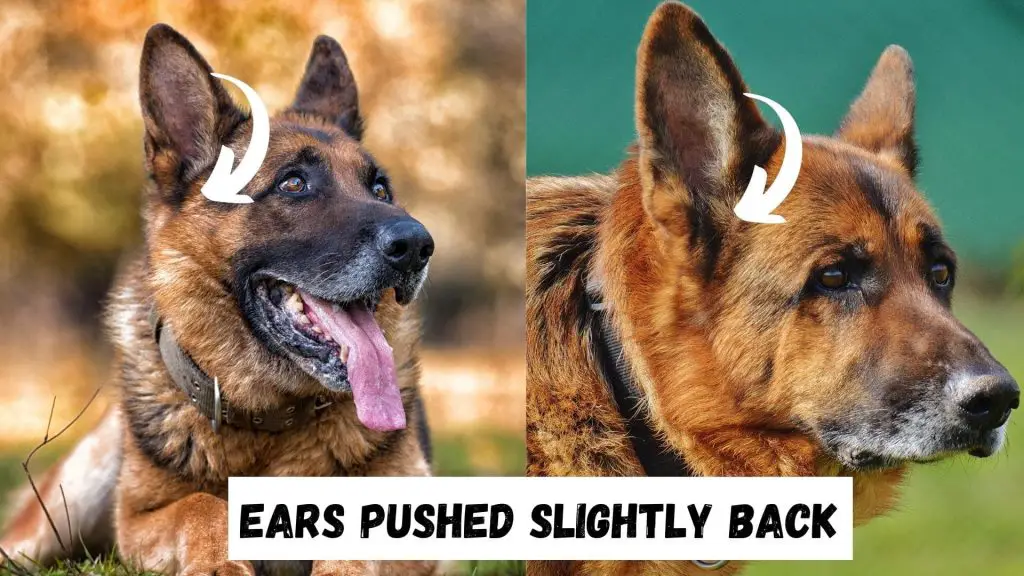
When your GSD’s ears are back and almost flattened against their head, It can signify submission or fear.
In addition, when a dog puts their ears back, they can also be happy and excited while also being submissive. This movement of the ears is only sometimes apparent and can be quite subtle.
Why Do German Shepherds Put Their Ears Back?
German Shepherds will often put their ears back when they are feeling submissive. This is a sign of submission and can be seen when they are around other dogs or people they see as higher ranking than them.
If your German Shepherd sees another much bigger dog, their ears may go back out of fear. However, their body will also likely tense up, and they may tuck their tail between their legs.
On the other side, if your German Shepherd’s tail is wagging and their body is relaxed, but their ears are back, it usually means they are happy and want to please you or play.
This is a common ear position for German Shepherds that are well-trained and obedient. However, if you notice your dog’s ears are pushed back, and their body seems tense, they might be anxious.
What to Do When Your GSD Puts His Ears Back
When your GSD puts his ears back, the best thing you can do is pay attention to the rest of their body.
Generally, it’s not a cause for concern, so no action is needed. So, if their ears are back, but their tail is wagging, they’re probably just happy. However, Suppose your German Shepherd’s ears go back and start showing other signs of fear or anxiety, such as crouching down or tucking their tail. In that case, it’s best to remove them from the situation.
You don’t want their fear to escalate and turn into aggression. Additionally, if your GSD is prone to being anxious or reactive, enroll them in classes to build their confidence.
Ears Down
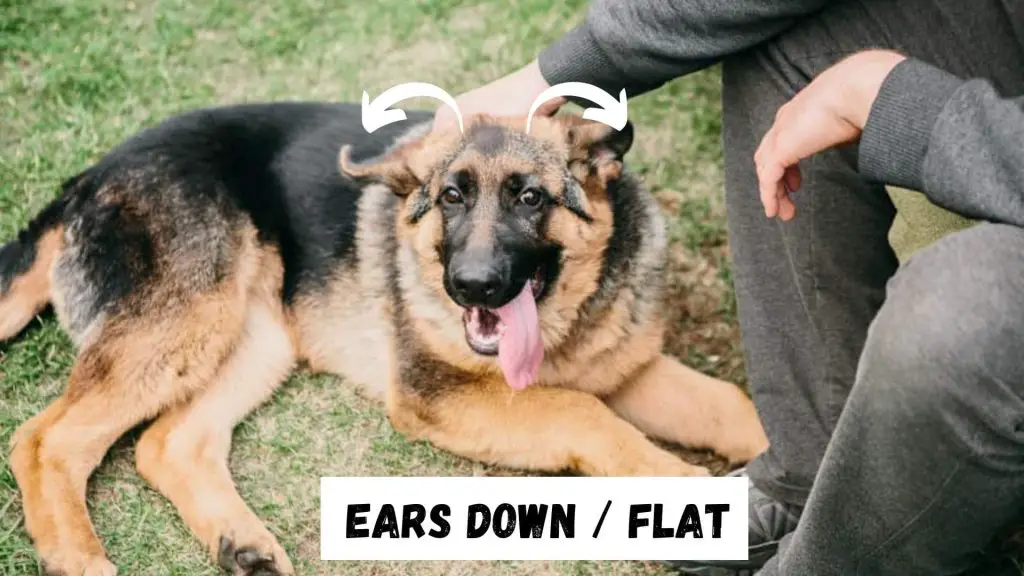
When a German Shepherd’s ears lay flat down against their head, it’s very noticeable. It’s the most prominent position because it does not look natural. Especially for German shepherds, who’s ears are usually erect.
Why Do German Shepherds Put Their Ears Down?
There are various reasons a German Shepherd will put their ears flat down.
If your GSDs ears drop, it might indicate illness, fear, or anxiety. For example, dogs in unfamiliar environments may act frightened, and their ears will go down as a visible reaction to this feeling.
German Shepherds may also be afraid of certain people or animals, which can make their ears react this way. This is usually accompanied by a hunched or rigid body, whimpering, or other fear signals. They might even try to hide their face if they are petrified.
This ear position signals something is wrong, and you should assess the situation.
What to Do When Your GSD Puts His Ears Down?
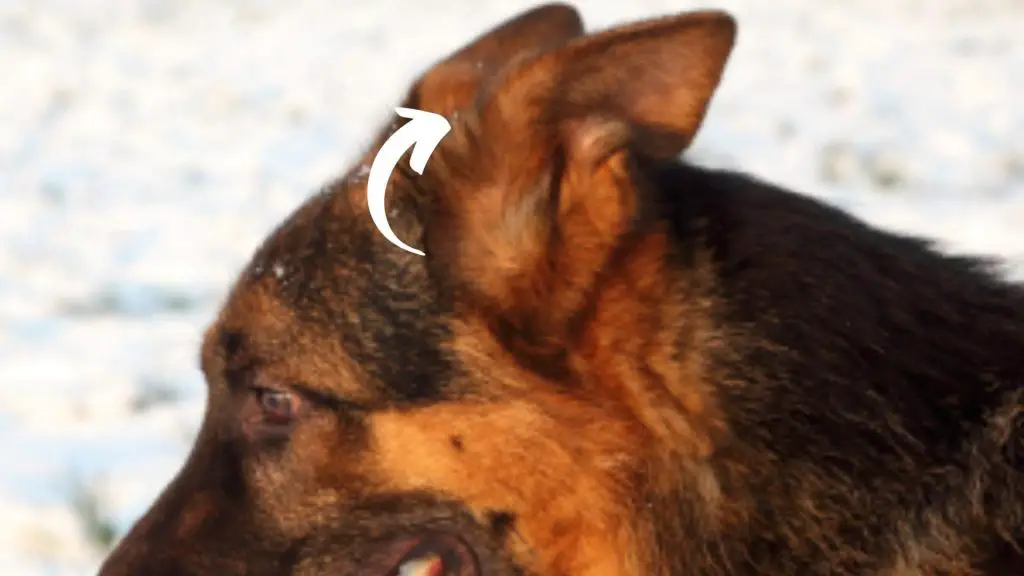
If your GSD is putting his ears down, you need to take a step back and assess the situation.
If your dog is uncomfortable in a new or unknown environment, don’t force them to socialize.
If they’re not getting any better after some time, or if their fear seems unreasonable, talk to a trainer or behaviorist. They can help you figure out what the problem stems from and how to address it most effectively.
Consider getting them checked out by a vet to eliminate the possibility of sickness. Generally, if they are sick, you will notice other symptoms, such as lethargy, lack of appetite, or vomiting.
This ear position should be addressed, especially if it’s combined with other body language cues.
Ears In Opposite Directions
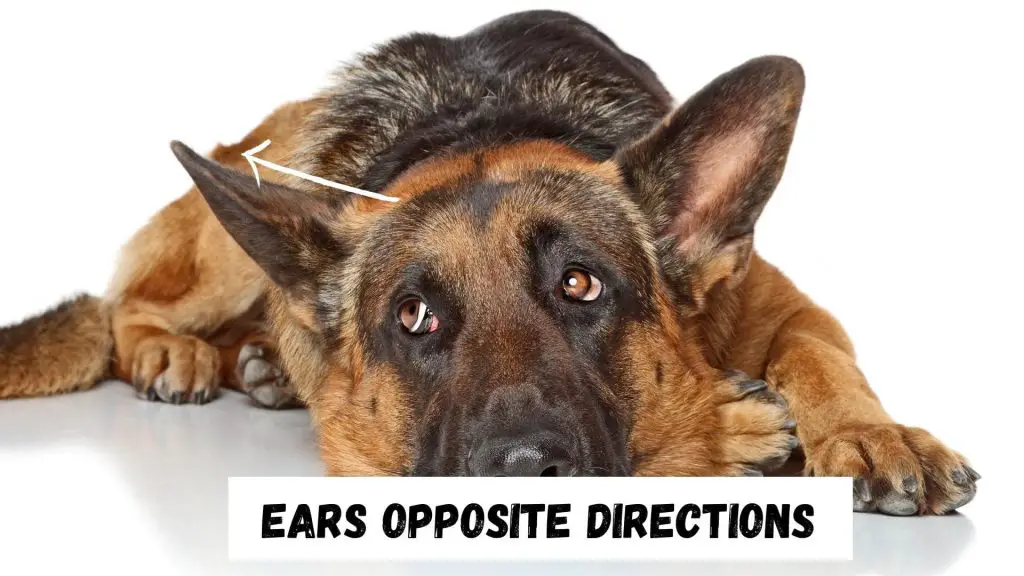
A German Shepherd with ears pointed in two separate directions occurs when they are trying to focus on two things simultaneously.
This may happen when sounds are coming from multiple directions, or they are trying to focus on both you and something else.
It may also happen when they are trying to figure out what is going on and trying to make sense of a situation. This ear position does not happen often, but when it does, it’s pretty darn cute.
Why Do German Shepherd’s Ears Stand Up?
The most common reason a German Shepherd has their ears standing up is that they are alert and paying attention to something. This could be anything from somebody walking by outside to a noise coming from another room.
German Shepherds are known for being attentive, and having erect ears is part of that. So if you notice your GSD’s ears perked up and pointing forward, it usually means they are trying to listen to or see something.
In addition, this ear position is often seen in reactive German Shepherds. For example, if a GSD is reactive to other dogs, as soon as they see one, their ears will stick up and move slightly forward, followed by their whole body tensing up.
Do All German Shepherd Ears Stand Up Straight?
It’s a common misconception that all German Shepherd’s ears stand up straight. Some GSDs have floppy ears that may never stand up fully. This is due to several factors but is generally not something to worry about. Nevertheless, roughly 20% of all German Shepherds end up with floppy ears.
A German shepherd’s ears may not be fully erect for various reasons, such as weak cartilage due to genetics, parasites, or damage from an injury. However, the most common reason is weak cartilage.
However, If your German Shepherd has floppy ears but they’re healthy, there is no need to worry. They may have weak cartilage and permanent floppy ears.
Here are the percentages of German Shepherds that ear will stand up by age:
- 3-4 months 28%
- 5-6 months 25%
- 7-8 months 16%
- 9-10 months 6%
- 11-12 months 3%
- After 1 year 4%
- Never 18%
German Shepherd Puppy Ear Stages
So now that you know a German Shepherd’s ear positions, what they mean, and the percentage of GSDs with floppy ears, you may be wondering about the natural ear stages of a German Shepherd puppy.
All German Shepherd puppies are born with their ears flopped down over their head. They will usually start to stand up around three weeks old, but it can take months to fully erect.
Here are the German Shepherd puppy ear stages:
Newborn To 5 Months
Between being born and 5 months, a german shepherd’s ears will begin to slowly stand up. Every GSD is unique. Some may take longer than others.
Since this is a delicate time for the growth of your ears, try not to put any pressure on them or force them up. This can interfere with the natural ear cartilage development. Just let them stand up unassisted, and most of the time, they will develop properly.
During this period, the cartilage of their ears will get stronger, and their ears will begin standing. As mentioned above, 53% of German Shepherd puppies have their ears stand up between 3-6 months.
German Shepherds teethe at around three months old, and this can sometimes reflect in their ears drooping. This is normal and not something to worry about.
And remember, if your GSDs ears are still not standing, many don’t until 6-12 months, and some never do!
5-6 Months
At this point, most German Shepherd puppies will have their ears standing up most of the time. Of course, they may still fall down from time to time, but they should be getting stronger and more erect.
If your GSDs ears are not standing by now, don’t worry. Some will take longer. At 5 months is when teething ends. This is a common time for their ears to become noticeably erect.
7-8 onths
At 7-8 months, if a German Shepherd’s ears are still not standing, there is a chance they never will. However, 16% of GSDs this age get their erect ears, so there is still a chance.
Your dog’s ears should appear strong and mostly erect. If they are considerably floppy with no improvement, you may want to consult your vet, as this could be a sign of an ear infection or other issue.
After 8 months
After 8 months, if your German Shepherd’s ears are not standing most of the time, it’s unlikely they will. While 13% of GSDs ages 9-12 months develop erected ears, the chances decrease substantially after that.
If your German Shepherd is over a year old and their ears are still not standing, they won’t have erect ears. However, it’s still a good idea to get them checked out just in case of an infection or other health issues.
Let’s discuss why some German Shepherds’ ears never become erect.
Why Are My German Shepherd’s Ears Floppy?

A few things may cause your German Shepherd’s ears to be floppy. Let’s explore these causes.
#1 Not Developed Yet
This is the most common reason for floppy ears in German Shepherds. If your GSD is under one year old, their ears may not be fully developed. Just like human babies, it takes time for their cartilage to grow and strengthen.
The best thing to do if your German Shepherd has floppy ears is to wait! Most of the time, their ears will stand up on their own.
If your German Shepherd is older than one year and their ears are floppy, there may be something else going on. Let’s discuss the other potential causes.
#2 Genetics
German Shepherds with floppy ears may be genetically predisposed to having them. This is often the case if both of their parents also have floppy ears.
If this is the case, there is nothing you can do to make their ears stand up. You will have to accept that they will always be floppy.
#3 Teething
Teething can sometimes cause a German Shepherd’s ears to be floppy. This is because the act of teething can release hormones that can interfere with cartilage development. In addition, during teething, the muscles in their face may loosen, which can also cause their ears to appear floppy.
Teething usually occurs around 3 months old and ends around 6 months old.
So if your German Shepherd’s ears are floppy and they are teething, they should go back to normal once their adult teeth come in.
#4 Breeding
Bad breeding is sometimes the root of floppy ears in dogs. For example, if a German Shepherd’s parents were not bred correctly, their puppies could have health problems – one of which being floppy ears.
Some breeders will try to purposely breed dogs in ways to make their ears larger. However, this can lead to their ears being oversized and too heavy for the cartilage to hold them up.
A knowledgeable breeder can tell you if dogs with droopy ears are present in the lineage of the puppy you want.
#5 Nutrition
Another reason for floppy ears is poor nutrition. A GSD that is deficient in certain vitamins and minerals may not develop strong ear cartilage.
For example, a lack of Vitamin C can result in weak connective tissue, which can lead to floppy ears. Make sure your German Shepherd is getting a high-quality diet that has all the nutrients they need for healthy development.
You can also supplement with vitamins, such as Vitamin C, to make sure they are getting enough. It is best to consult with your vet to make sure your pup is not deficient in anything.
#6 Hygiene
If you don’t clean your German Shepherd’s ears regularly, they could develop an infection. Ear infections are one of the most common reasons for floppy ears in dogs.
The infection could be caused by bacteria, yeast, or even mites. If your German Shepherd has an ear infection, they will likely have symptoms such as:
- Shaking their head
- Scratching their ears
- Odor coming from their ears
- Redness or swelling in their ears
- Discharge from their ears
If you think your German Shepherd has an ear infection, you should take them to the vet right away. The vet will likely prescribe antibiotics or other medication to clear up the infection.
Once the infection is gone, their ears should return to normal.
#7 Injuries
An injury to the ear can sometimes cause it to be floppy. This is because the ear is made up of delicate cartilage and skin.
If your German Shepherd has floppy ears due to an injury, it is best to take them to the vet. The vet will likely prescribe medication or give you instructions on how to care for the injury at home.
With time and proper care, their ears should heal.
Further Readings: How To Clean Dogs Ears When They Hate It: 9 Simple Steps
Final Thoughts
A German Shepherd’s ears can mean a lot of things. How their ears move and body language can give insights into how they feel.
The position of German Shepherds’ ears can act as communication and an expression of emotions. For example, when a dog’s ears are pricked forward, it usually indicates your dog is alert and interested in what is happening around them.
If a dog’s ears are back, it can mean they are nervous or submissive, or they could actually be happy. You can usually tell how your dog feels when looking at their ears and body posture. In this example, if GSDs’ ears are back and their head is down, they are probably submissive or nervous.
The position of your German Shepherd’s ears can also give you an indication of their health. For example, if their ears are floppy, it could signify teething or poor nutrition. In addition, ears that are down and flat against the head can indicate illness.
This is why it’s essential to know your GSDs ear positions and what they mean!
Other posts you might find interesting:
Dog Scratching Ear And Shaking Head At Night? (Vet Answers)
Brown Pigment In White Of Dog’s Eye: Is It Pigmentary Keratitis?
